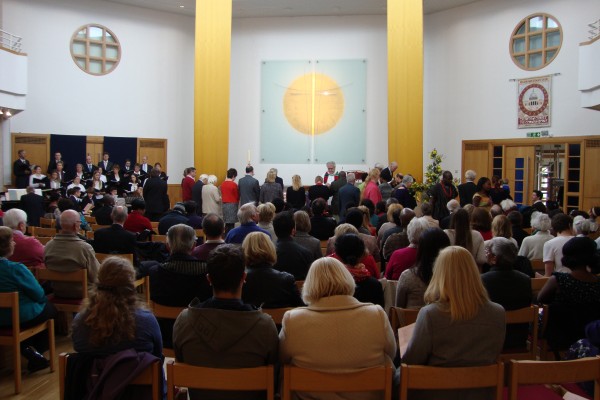Music to end the Day, Sunday 2 May 2021
The last two Sundays of Easter focus on inspirational words from St John’s Gospel, chapter 15.
If you dwell in me and my words dwell in you,
ask whatever you want and you shall have it.
This is how my Father is glorified:
you are to bear fruit in plenty and so be my disciples.
As the Father has loved me, so I have loved you.
Abide in my love.
Our musical offerings this evening, each from a different tradition, reflect St John’s great theme. First we hear Alison Robertson’s lovely hymn ‘Love is the touch of intangible joy’ set to a simple folk-like melody by John Bell of the Iona Community. Alison Robertson (b. 1940) is an Edinburgh musician, minister’s wife, former teacher, and secretary of the Scottish Stained Glass Symposium. One of her aims in this hymn was to write something that people who may not subscribe to the Christian faith could still assent to and be helped by. The ‘lingering voice’ in verse 2 refers to the voices of those who have gone before and still matter to us.
Love is the touch of intangible joy
Love is the force that no fear can destroy
Love is the goodness we gladly applaud
God is where love is, for love is of God
Love is the lilt in a lingering voice
Love is the hope that can make us rejoice
Love is the cure for the frightened and flawed
God is where love is, for love is of God
Love is the light in the tunnel of pain
Love is the will to be whole once again
Love is the trust of a friend on the road
God is where love is, for love is of God
Love is the Maker, and Spirit, and Son
Love is the kingdom their will has begun
Love is the pathway the saints all have trod
God is where love is, for love is of God
Hymn – Love is the touch of intangible joy
Written by Alison M. Robertson and set to AMOR DEI composed by John Lamberton Bell.
We now hear Tom Colvin’s ‘Kneels at the feet of his friends’, another reflection on St John’s Gospel. Colvin, a long-term missionary to Africa, wrote the text in 1963 in Chereponi, North Ghana, while attending a training course in agriculture, development and evangelism. New converts had brought a folk melody to the meeting, which they thought might be appropriate for a text about Christian love. Colvin explains: “Sitting there in the moonlight, I felt it had to be about black and white, rich and poor. I was ashamed of the wasteful affluence of my people but proud of the Gospel that transforms us into servants of one another. It is only when we who are rich learn to have the humility of the slave towards the poor of the world that we shall be able to learn from them, they have so much to teach us and share with us.”
Jesu, Jesu, fill us with your love
show us how to serve the neighbours we have from you
Kneels at the feet of his friends
silently washes their feet
Master who acts as a slave to them
Jesu, Jesu, fill us with your love
show us how to serve the neighbours we have from you
Neighbours are rich and poor
varied in black and white
neighbors are dear and far away
Jesu, Jesu, fill us with your love
show us how to serve the neighbours we have from you
These are the ones we should serve
these are the ones we should love
all these are neighbours to us and you
Jesu, Jesu, fill us with your love
show us how to serve the neighbors we have from you
Kneels at the feet of our friends
silently washing their feet
this is the way we should live with you
Jesu, Jesu, fill us with your love
show us how to serve the neighbours we have from you
Jesu, Jesu, fill us with your love
Words written by Tom Colvin, set to the melody CHEREPONI from Ghana collected by Tom Colvin. Arranged and performed by Adrian Boynton.
Now we hear Norwegian composer Ola Gjeilo’s setting of Ubi Caritas, written in 1999. Now in his early 40s, Gjeilo has become one of today’s leading choral composers. He graduated from the prestigious Juilliard School, New York, in 2006. Ubi Caritas, first published in America, was one of his first ‘breakthrough’ works. Gjeilo talks at length about ‘finding your own voice’ as a composer. He says “It’s easy to get caught up in external factors and ask ‘what does my teacher want?….. what are others expecting of me?…… We get distracted from the core question – What is it that I really love? This should be the benchmark for all composers – if we don’t enjoy our own music, audiences won’t either.”
In writing Ubi Caritas Gjeilo is influenced by Duruflé’s earlier 1960s setting. He takes inspiration from the traditional chant that Duruflé used, but then adds his own twist to the text, with evocative harmonies, to make it come alive in a different way.
Ubi caritas et amor, Deus ibi est
Congregavit nos in unum Christi amor
Ubi caritas et amor, Deus ibi est
Congregavit nos in unum Christi amor
Christi amor
Exsultemus, et in ipso jucundemur
Timeamus, et amemus Deum vivum
Exsultemus, et in ipso jucundemur
Timeamus, et amemus Deum vivum
Timeamus, et amemus Deum vivum
Deum vivum
Et ex corde diligamus nos sincero
Et ex corde diligamus nos sincero
Ubi caritas et amor, Deus ibi est
Congregavit nos in unum Christi amor
Amen
which translates as:
Where charity and love are, God is there
The love of Christ has gathered us together
Let us rejoice, and be glad in it
Let us revere and love the living God
And from a sincere heart let us love one another
Amen
Ubi Caritas [Gjeilo]
Words written by Paulinus of Aquileia. Composed by Ola Gjeilo.
Sung a cappella by the Choir of Christ the Cornerstone, Milton Keynes, directed by Adrian Boynton.
We end this sequence with Chopin’s Waltz in A flat major, Op 69 No 1, a celebration of human love known also as ‘Valse de L’adieu, the work was written as a farewell piece to Maria Wodzinska, to whom Chopin was once engaged. An autographed copy, marked ‘Pour Mlle Maria was given to her in Dresden in September 1835. The main theme marked ‘con espressione’ is melancholic and nostalgic. A second theme marked ‘con anima’ (with soul) is more cheerful, but quickly gives way to a return of the opening theme. A third theme, marked ‘dolce’ (sweetly) is more playful and leads to a fourth theme, ‘poco a poco crescendo’ in ascending double stops. The third theme reappears, before a final return to the melancholic mood of the opening melody.
Piano postlude – Waltz in A flat
First movement from opus 69 composed by Frédéric Chopin
Finally a prayer:
Heavenly Father, you sent your Son into the world that we might live through him. May we abide in his risen life so that we may bear the fruit of love for one another and know the fullness of joy.
Amen.
Goodnight everyone.
Adrian Boynton


